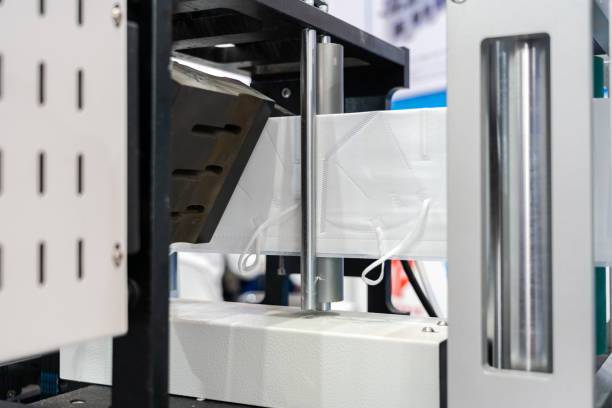by Haoxin Safety
Share
by Haoxin Safety
Share

The ongoing global pandemic has made one thing clear – the importance of personal protective equipment (PPE). Among the various types of PPE available, the KN95 mask has emerged as a popular choice for its effectiveness in filtering out harmful particles. But have you ever wondered what goes into the manufacturing process of these life-saving masks? In this article, we take a closer look at the behind-the-scenes operations of a KN95 mask factory in China, where these masks are produced on a large scale to meet the growing demand. From the raw materials used to the intricate steps involved in the production process, we delve into the details to give you a better understanding of how these masks are made. So, put on your safety goggles and join us on a fascinating journey to explore the manufacturing process of KN95 masks in China.
What are KN95 Masks?
KN95 masks are a type of respiratory protective equipment used to filter out airborne particles. They are similar to the N95 masks used in the United States, but with slight differences in their specifications. The KN95 mask is designed to have a filtration efficiency of at least 95%, meaning it can filter out at least 95% of airborne particles. These particles can include dust, smoke, pollen, and even viruses and bacteria. KN95 masks are made of multiple layers of synthetic materials, each serving a different purpose in the filtration process.
Importance of KN95 Masks in the Pandemic
The global pandemic caused by the COVID-19 virus has resulted in an unprecedented demand for PPE, including KN95 masks. The virus can spread through respiratory droplets and contact with contaminated surfaces, making it crucial to wear masks to reduce the risk of transmission. KN95 masks have become a popular choice for their effectiveness in filtering out harmful particles, making them an essential tool in the fight against the pandemic. The demand for KN95 masks has skyrocketed, with many countries importing them from China to meet the growing need.
Manufacturing Process of KN95 Masks
The manufacturing process of KN95 masks involves several steps, each requiring specialized equipment and skilled workers. Here’s a breakdown of the process:
Raw Materials Used in Making KN95 Masks
The raw materials used in making KN95 masks include non-woven polypropylene fabric, static electret melt-blown fabric, nose clips, and earloops. The non-woven polypropylene fabric is used to form the outermost layer of the mask and provides protection against larger particles. The static electret melt-blown fabric is used to form the middle layer of the mask and provides the primary filtration function, trapping smaller particles. The nose clip is made of metal and is used to secure the mask to the nose, while the earloops are made of elastic and are used to secure the mask to the face.
Equipment and Machinery Involved in the Manufacturing Process
The manufacturing process of KN95 masks involves specialized equipment and machinery that can produce masks on a large scale. The machines used in the production process include ultrasonic welding machines, edge banding machines, and mask cutting machines. The ultrasonic welding machine is used to bond the layers of the mask together, while the edge banding machine is used to seal the edges of the mask. The mask cutting machine is used to cut the mask into its final shape.
Quality Control Measures for KN95 Masks
Quality control is an essential aspect of the manufacturing process for KN95 masks. The masks must meet strict quality standards to ensure their effectiveness in filtering out harmful particles. Quality control measures include testing the filtration efficiency of the masks, checking for defects in the materials used, and inspecting the finished products for any visible defects.
Challenges Faced during the Manufacturing Process
The manufacturing of KN95 masks is not without its challenges. One of the biggest challenges faced by manufacturers is the shortage of raw materials. The demand for KN95 masks has led to a shortage of non-woven polypropylene and static electret melt-blown fabric, which are essential materials in the production process. Another challenge faced by manufacturers is ensuring that the machines used in the production process are functioning correctly. Any defects in the machines can lead to defects in the finished products.
Future Outlook for KN95 Masks Manufacturing
The demand for KN95 masks is expected to remain high in the coming years, as the world continues to battle the COVID-19 pandemic. KN95 mask manufacturers in China are ramping up production to meet the growing demand, and new factories are being built to increase capacity. However, the shortage of raw materials remains a concern, and manufacturers are looking for alternative materials that can be used in the production process.
Conclusion
The manufacturing process of KN95 masks in China involves intricate steps that require specialized equipment and skilled workers. The masks are made of multiple layers of synthetic materials, each serving a different purpose in the filtration process. Quality control measures are in place to ensure that the masks meet strict quality standards. Despite the challenges faced by manufacturers, the demand for KN95 masks is expected to remain high in the coming years. The manufacturing of these life-saving masks is essential in the fight against the COVID-19 pandemic and highlights the importance of PPE in protecting public health.
